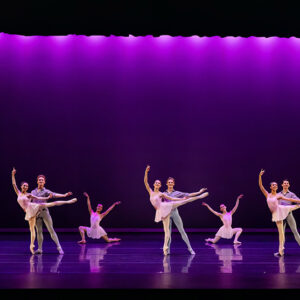calsfoundation@cals.org
Ballet Arkansas
Ballet Arkansas is a professional dance company headquartered in Little Rock (Pulaski County). Ballet Arkansas has been listed among the Top 100 Largest Ballet Companies in America by the Dance Data Project and has a yearly audience of thousands. The organization’s repertory consists of celebrated masterworks by George Balanchine, Gerald Arpino, Agnes De Mille, Val Caniparoli, Ma Cong, and Christopher Wheeldon, among others. A statewide leader in dance education, Ballet Arkansas serves hundreds of children and adults in Central Arkansas. The organization is a partner company in residence at the Arkansas Museum of Fine Arts and the UA-Pulaski Tech Center for Humanities and Arts. Annual performances such as The Nutcracker Spectacular feature the Arkansas Symphony Orchestra and are presented at the Robinson Auditorium.
Ballet Arkansas began with the work of Little Rock native Donald Cater Cranford, who moved back to Little Rock from Dallas, Texas, in the mid-1960s. In 1957, he and his wife Lorraine Albert Cranford had founded the Cranford House of Ballet, which developed dancers for the Dallas Civic Ballet. The Dallas Civic Ballet was anchored by an annual performance of the Christmas standard ballet, The Nutcracker. D. Cater Cranford founded the Little Rock Civic Ballet in 1966, following the same model that had succeeded in Dallas; Lorraine Cranford joined him in Little Rock several years later. When the Arkansas Arts Center (now the Arkansas Museum of Fine Arts) began conducting ballet classes and performances in the 1970s, it invited the Little Rock Civic Ballet to participate; the efforts eventually merged. D. Cater Cranford died in 1977; Lorraine Cranford founded Ballet Arkansas in 1978. Cranford remained active in the company under various boards and directors until her death in 2004.
In 2009, Ballet Arkansas hired a new artistic director, Arleen Sugano, along with six professional dancers for the 2009–2010 season, re-establishing the professional company that had been disbanded in 2000; Sugano left the company in 2011. Following the debut of the Professional Dance Company at the 2009 “Arts in Concert,” Ballet Arkansas received extensive positive feedback from the Little Rock community and was featured on the cover of both Arkansas Life and the Arkansas Times. In January 2010, Ballet Arkansas hosted Kiesha Lalama-White from Point Park University in Pittsburgh, Pennsylvania, to teach a master class open to the public and to choreograph an original piece for the company. Searcy (White County) native Michael Bearden, who had trained with Ballet Arkansas before embarking on a career as a dancer, choreographer, and educator, joined the company as an artistic consultant in 2013 and then as artistic director. During his tenure, the company expanded to thirteen dancers. In 2015, the company presented renowned choreographer George Balanchine’s Who Cares?, marking the first time an Arkansas dance company performed an officially sanctioned Balanchine work.
In 2016, Ballet Arkansas moved into new offices and studio space on Main Street in downtown Little Rock as part of the City of Little Rock’s Creative Corridor initiative. Bearden resigned in 2017 to become the director of the University of Oklahoma’s School of Dance. He was succeeded that same year by executive and artistic director Michael Fothergill, who was formerly a principal dancer and choreographer for Alabama Ballet. His wife, Catherine Garratt Fothergill, also formerly a principal dancer for the Alabama Ballet, became associate artistic director and director of marketing. Under the Fothergills’ direction, the company eliminated its debt, doubled its gross operating budget, and revitalized its programming.
Ballet Arkansas faced legal hardships at various points in its history. As part of the American bicentennial celebration in 1976, the company (still called the Little Rock Civic Ballet) performed an interpretation of the Legend of Petit Jean. The company was subsequently sued by author Marguerite Turner, who claimed that the performance used elements of her telling of the Petit Jean story without her permission and without acknowledgement of her writing. Turner sought $300,000; she won her case in March 1980 but was awarded only $1,250. In 2000, the company was again in the courts following the decision of the board of directors not to renew the contracts of artistic director Kirt Hathaway and of his wife, principal dancer and academy director Linda Hathaway. During the eight years the Hathaways were employed by Ballet Arkansas, the academy had grown from seventy students to 230 students, and a nine-member professional company was begun. The board, citing financial constraints, sought a new director, and the professional company was disbanded. Some of the dancers and their families went on to found Arkansas Festival Ballet, with the support of Lorraine Cranford. In the interim, parent Marilyn Sutton sued for disclosure of the company’s financial information, citing Freedom of Information laws, since the company received government grants. Her suit was denied in court on the grounds that Ballet Arkansas was not itself part of any government agency. Linda Hathaway also sued the company for $75,000 but was likewise unsuccessful.
Over the years, Ballet Arkansas has provided many exceptional dance experiences for audiences as well as dancers. Examples include Cynthia Gregory (American Ballet Theatre) performing with Ballet Arkansas in 1980 and Mikhail Baryshnikov (American Ballet Theatre) performing in Little Rock in 1983. The company received the “Stream Award” for artistic excellence from the Southwestern Regional Ballet Association in 1992.
For additional information:
Ballet Arkansas. https://www.balletarkansas.org/ (accessed July 3, 2023).
Eifling, Sam. “En Pointe: Ballet Arkansas Goes Pro.” Arkansas Times, December 10, 2009, pp. 10–11.
Harrison, Eric E. “Ballet Hopes ‘Inspired’ Nutcracker Helps Regrowth.” Arkansas Democrat-Gazette, December 5, 2008, p. 13W.
Schnedler, Jack. “Ballet Arkansas Is Taking Big Leaps Forward, Propelled by the Dynamic Leadership of Michael Fothergill and Wife Catherine.” Arkansas Democrat-Gazette, March 3, 2019. https://www.arkansasonline.com/news/2019/mar/03/michael-charles-fothergill-20190303/ (accessed July 3, 2023).
Craig Wilson
Ballet Arkansas
Staff of the CALS Encyclopedia of Arkansas
 Arts, Culture, and Entertainment
Arts, Culture, and Entertainment Choreography by Simon Kuban
Choreography by Simon Kuban  Choreography by Yuka Oba-Muschiana
Choreography by Yuka Oba-Muschiana  Choreography by Yuka Oba-Muschiana
Choreography by Yuka Oba-Muschiana  Reflections by Gerald Arpino
Reflections by Gerald Arpino 




Comments
No comments on this entry yet.